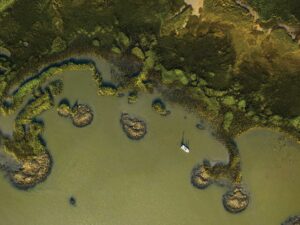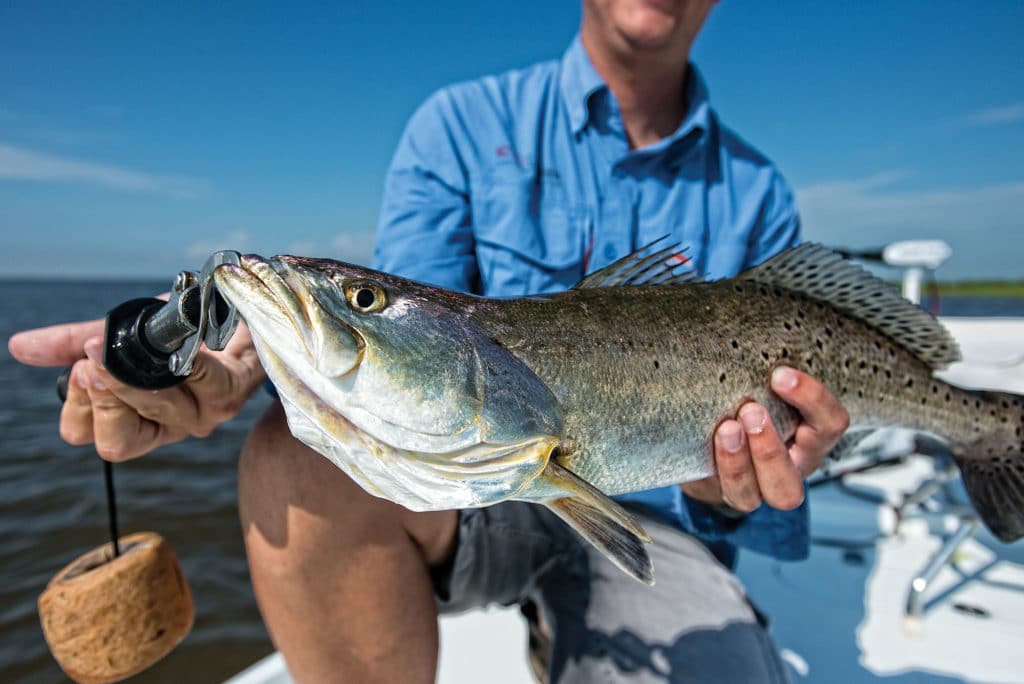
When anglers think about Louisiana fishing, most conjure images of game-fish-laden marshes, bays and backwater bayous so far off the grid that even the pelicans have a hard time finding some of them. But Lake Pontchartrain isn’t one of those remote spots.
Encompassing 630 square miles, this brackish waterway is a major corridor for not only vessels but also cars, trucks and trains traveling to and from New Orleans, Slidell or adjacent Metairie and Covington on the various bridges spanning its 12- to 14-foot-deep waters.
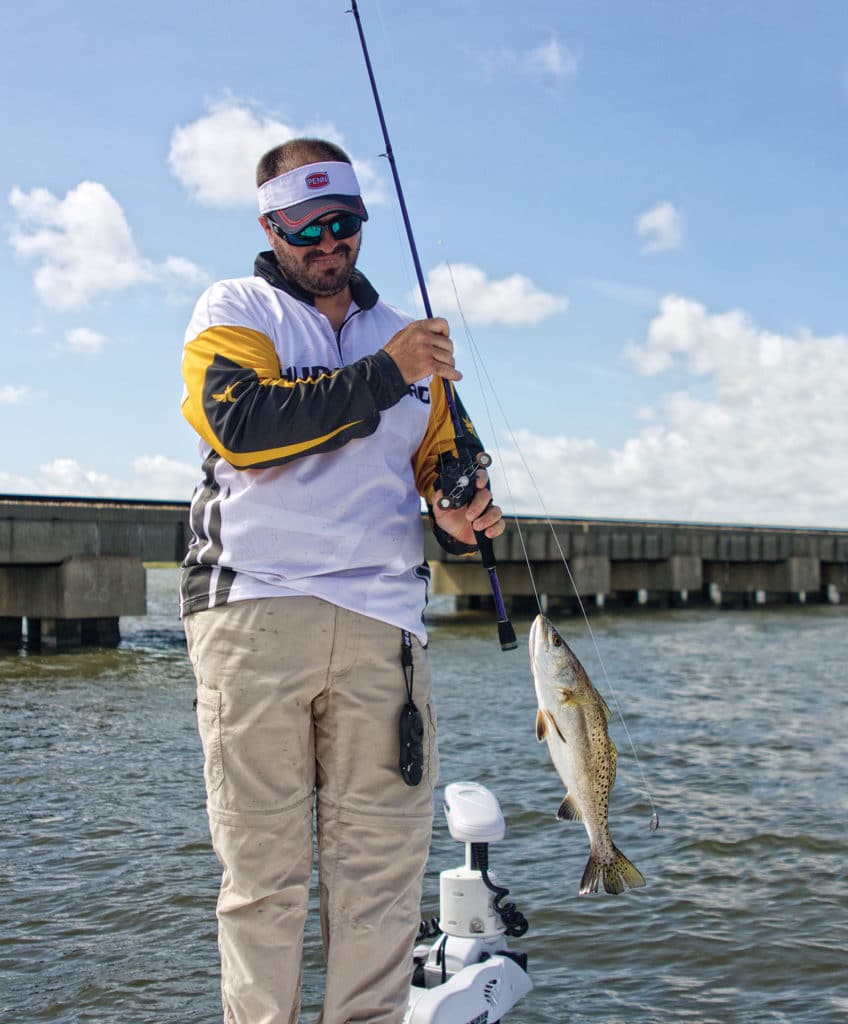
Fish Bridge Structure for Trout
All those pilings and trestles provide ideal structure to hold hefty speckled trout, which Lake Pontchartrain has a long history of producing. But the lake has a reputation for being difficult to decipher, so last spring I joined captains John Falterman Jr. and Brooks Levy, two veteran local guides, for a productive, albeit noisy, tutorial.
“There’s all kinds of cross members, broken pilings, and cables along the railroad trestle, so I rarely drop a regular anchor,” Falterman explained while he readied tackle aboard his 24-foot bay boat after a freight train rumbled by. “Usually I use Spot-Lock (virtual anchor mode on his Ulterra Rip Tide trolling motor) or my homemade piling anchor to hold position. If I mark fish on the finder, we work that area hard. If not, I keep moving until I find them. Sometimes that’s only three pilings away, and the minor move could be the difference between catching 12-inch dinks or 3-pounders.”
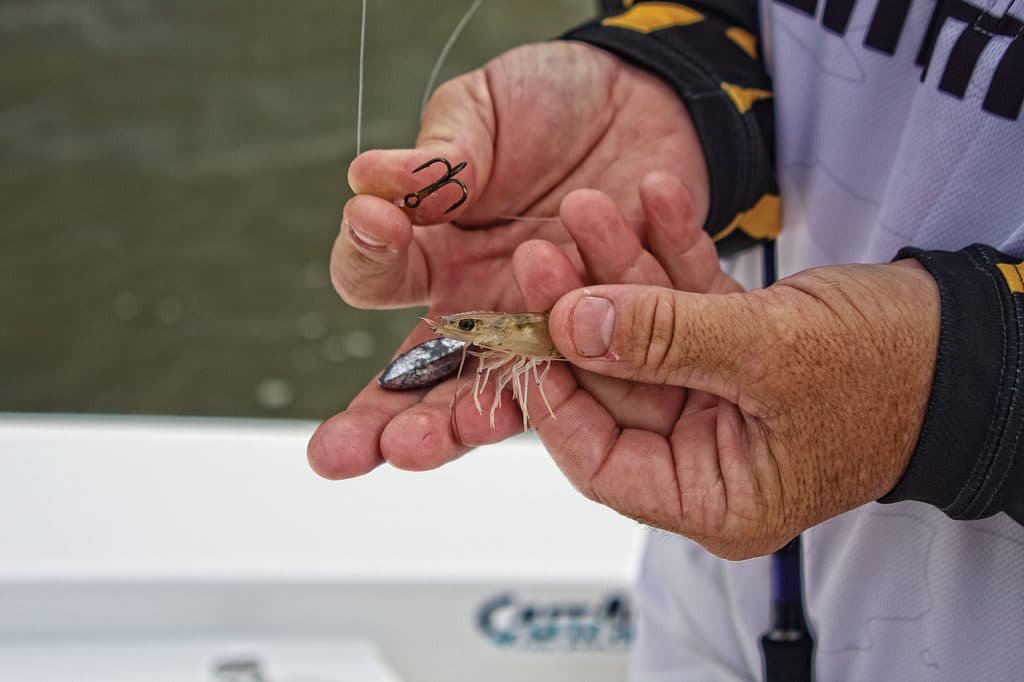
Best Conditions for Seatrout
Although Falterman believes the majority of the trout are year-round residents, salinity and water temperature are triggers for the big fish to gather along the bridge spans. Salinity is affected by wind and current from the Gulf, flood-control locks and causeways, but once the water temperature consistently tops 58 degrees, the larger specks are on the move. April historically kicks off the prime season, which lasts into June. By the time the water temperatures approach 90 degrees, the fish shift to deeper, cooler holes in nearby Lake Borgne.
“Six out of the 10 state-record trout were set in lakes Pontchartrain and Borgne,” Falterman says. “The big specks just show up one day, and the next you’re slaughtering them. And every month the average size gets bigger by the pound. In April, most trout are 3 to 4 pounds, with the occasional 5-pounder. We catch bigger fish, up to 7 pounds, in May and June. And, depending on the temperature and salinity, they may be even bigger.”
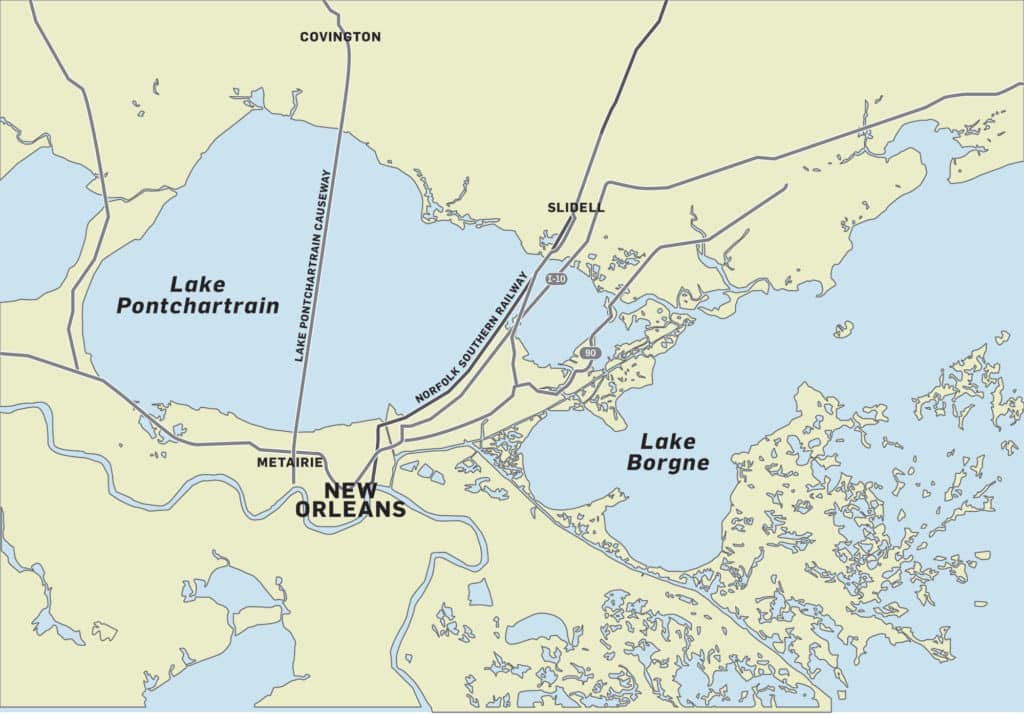
A Great Seatrout Rig
To minimize break-offs and entanglements, Falterman came up with a drop-shot setup for live shrimp. Using about 42 inches of 30-pound monofilament leader, he ties an overhand knot to form a loop and connects it to his 30-pound braided main line — which he first doubles up — using a fisherman’s knot. Next, he adds a 1-ounce bank sinker and a No. 6 bronze treble hook with improved clinch knots. The length of doubled leader keeps the shrimp off the bottom while the bank sinker holds in the current. “I don’t use a swivel,” Falterman says. “This way you’re connected straight to the bait, and when you feel that thump, you know the fish is there.” He adds that he normally goes through 40 live shrimp or more per angler, per trip.
Artificial lures are also effective on lake trout if anglers pay attention to the line to detect subtle strikes. Soft-plastic shad tails or glass minnow imitations, in colors that match the water clarity, rigged on ⅛- to ½-ounce jig heads are the local favorites. Falterman says jig-head color doesn’t really matter, since the paint is quickly knocked off after bouncing off a few concrete pilings. Techniques vary from holding the rod high and popping the lure every couple of minutes to a slow drop and twitch.
Where to Find Speckled Seatrout
“The lake is a make-or-break zone, and every day is different,” Falterman explains. “One morning the fish are right up against the pilings, and the next they’re 300 yards out. I tell my clients to fan-cast and change things up as needed to figure out where the fish are hanging and how they respond to the baits. I don’t stay in one spot for very long if trout don’t bite, and I’m always checking the sonar for schools of bait. You can actually pull a school of trout away from nearby boats if you come up with the presentation they prefer that particular day.”
In addition to the railroad bridge (the Norfolk Southern Railway), Falterman says the Interstate 10 twin-span and the Highway 90 bridges also hold fish, especially during slack current. Tidal range is less than 2 feet in Lake Pontchartrain, but the western sections are more popular regardless of flow. As the water warms through the season, the fish spread out along the various structures.
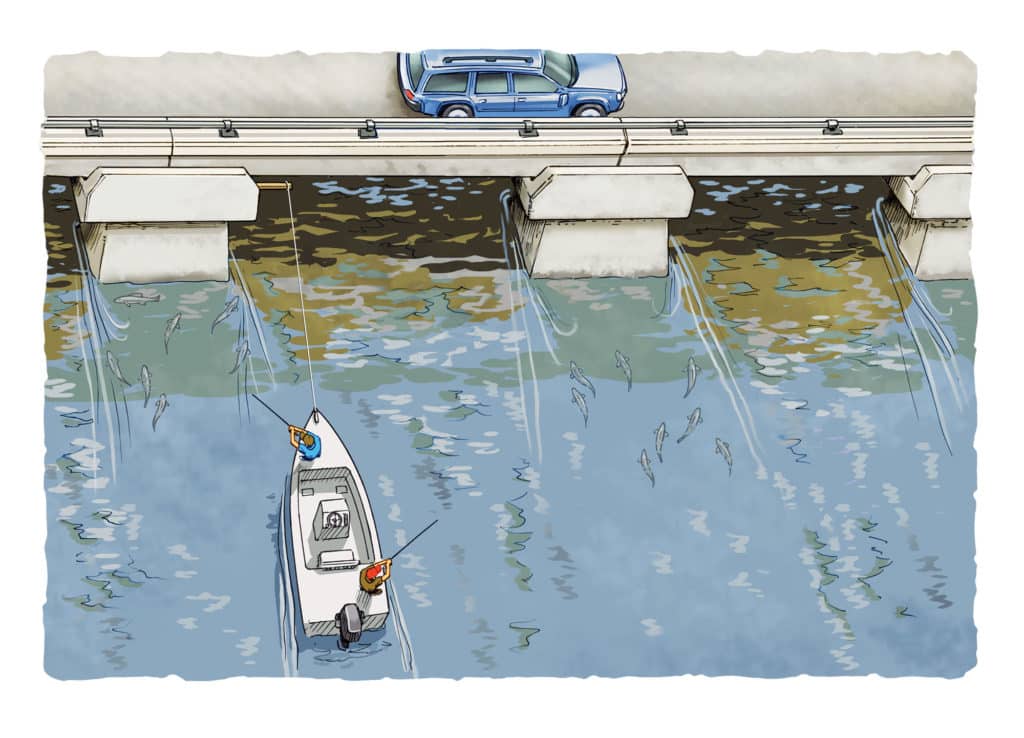
Favorite Lake Pontchartrain Fish
Besides quality trout, there are plenty of bonus species that roam around Lake Pontchartrain in the spring and early summer as well. Schools of redfish and black drum often pop up hundreds of yards beyond the bridges, harassing bait pods. Diving birds pinpoint the action. Topwater plugs and soft-plastic jigs usually meet with instant approval, and after the schools finally break up (or limits are met), the focus shifts back to the trout around the bridges, where big sheepshead and flounder up to 5 pounds often become part of the trout bycatch.
During our morning trip, we took full advantage of Louisiana’s generous 25-trout daily bag limit and caught a few dozen ranging in size from the 12-inch minimum up to the 4-pounder that inhaled my shrimp just before lines out. A 16-inch flounder also found its way into the ice chest.
“Newcomers often get frustrated fishing the lake the first few times,” Falterman explained as he deftly filleted the day’s catch. “But you just have to put in the time, keep an eye peeled for the bait, and move around until you find that particular piling or section where the fish are holding. Trust me, starting in April, they’ll be there, and they’ll be fat, healthy fish.”
Granted, Lake Pontchartrain is not Louisiana’s most natural setting, and you might want to bring along a set of earplugs when you fish there. But putting up with the noise, traffic and concrete backdrops is a small price to pay for a good stringer of big speckled trout.
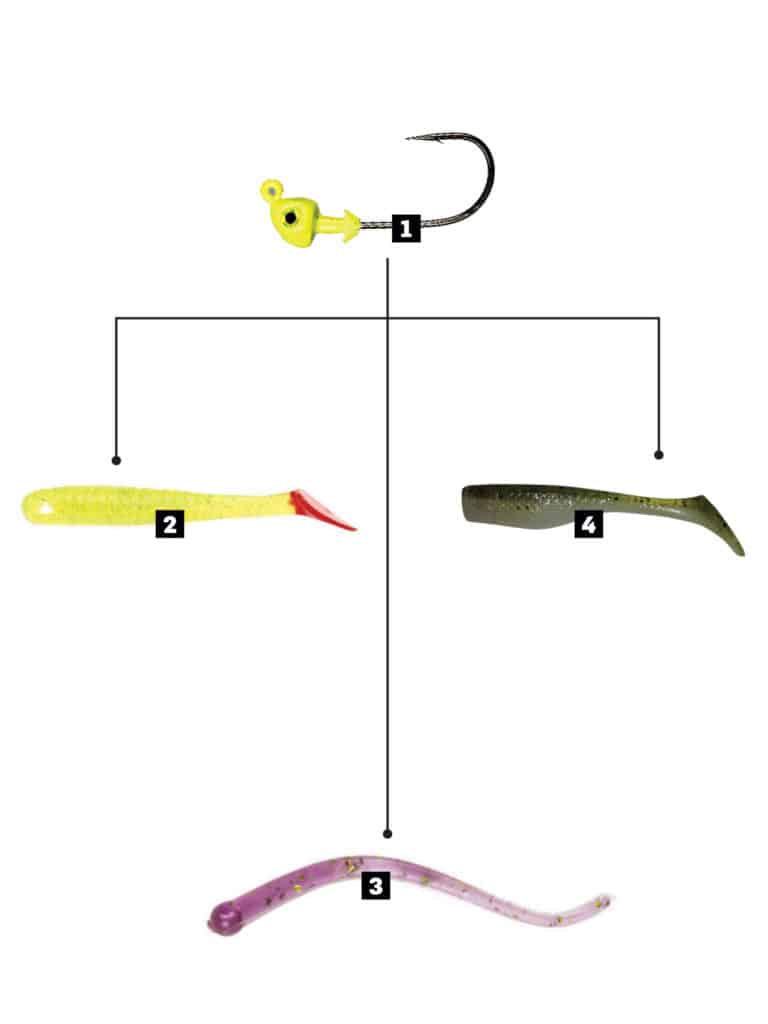
2.) The Crappie Psychic Trout Trailer combines scent and irresistible wiggling action.
3.) When trout feed on schooling baitfish, it’s hard to beat a Matrix Shad. SWS Staff
Bridge Fishing Tips
Scan the Span: Don’t just pick a spot at random. Find fish along a bridge with sonar, then set up within range. Search Pattern: Fan-cast and alter your retrieve often to pinpoint active trout and see how they respond to your efforts. Stick or Move: Don’t waste time. If the fish don’t bite in a few minutes, pick up and move to another spot.
Plan a Lake Pontchartain Fishing trip
- What: Speckled trout
- When: April, May, June and October
- Where: Lake Pontchartrain, Lake Borgne
- Who: Trout fishing in southeast Louisiana’s estuarine lakes is well-suited for do-it-yourselfers, but it does require a boat.
Louisiana Seatrout Tackle
- Rods: 7-foot medium-light-action spinning
- Reels: 3500 class spinning reels
- Lines: 30-pound braid
- Leader: 30-pound monofilament up to 42 inches long to double for the drop-shot rig
- Terminal tackle: No. 6 bronze treble hooks; 1-ounce bank sinkers
- Baits: Live shrimp
- Lures: Matrix Shad, Deadly Dudley Shad and Crappie Psychic Trout Trailer in black, green or blue for dark water, yellow and pink for medium-stained water, and chartreuse or white for clear conditions, rigged on 1⁄8- to 1⁄2-ounce jig.




